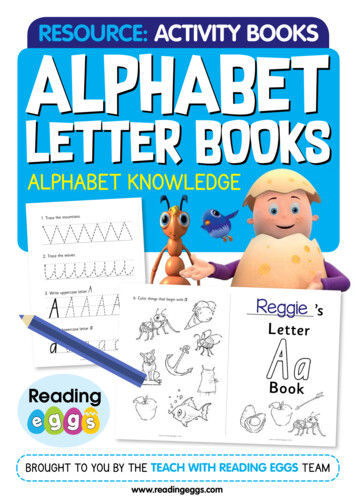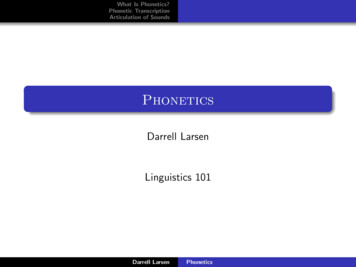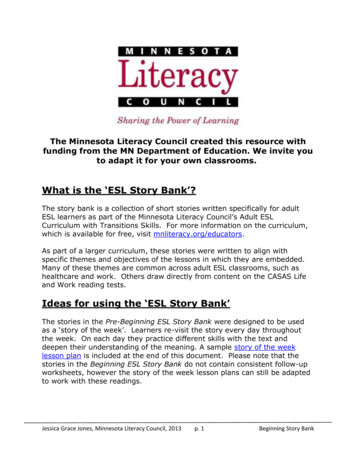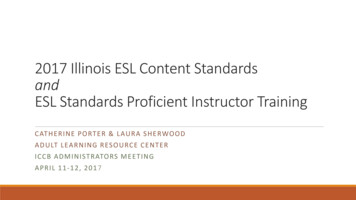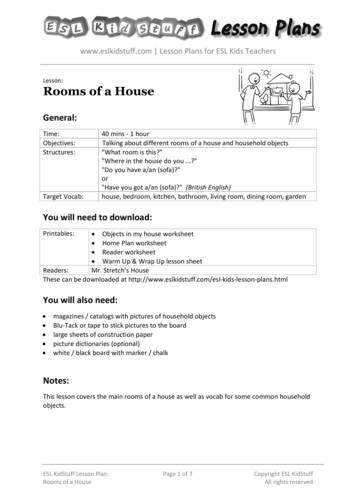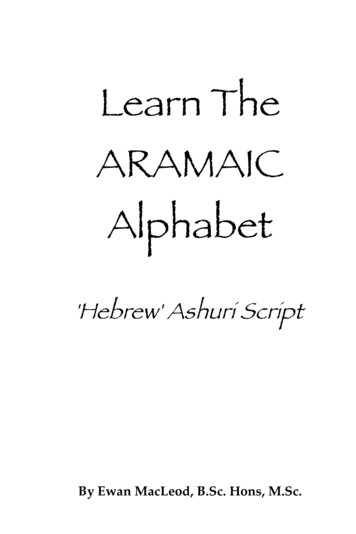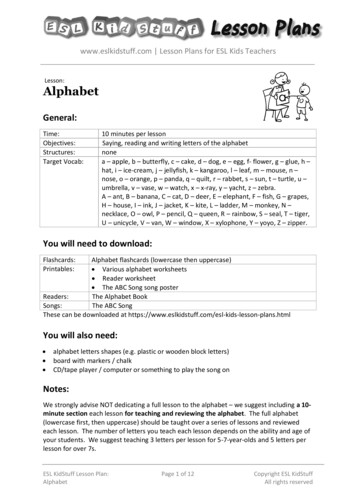
Transcription
www.eslkidstuff.com Lesson Plans for ESL Kids uctures:Target Vocab:10 minutes per lessonSaying, reading and writing letters of the alphabetnonea – apple, b – butterfly, c – cake, d – dog, e – egg, f- flower, g – glue, h –hat, i – ice-cream, j – jellyfish, k – kangaroo, l – leaf, m – mouse, n –nose, o – orange, p – panda, q – quilt, r – rabbet, s – sun, t – turtle, u –umbrella, v – vase, w – watch, x – x-ray, y – yacht, z – zebra.A – ant, B – banana, C – cat, D – deer, E – elephant, F – fish, G – grapes,H – house, I – ink, J – jacket, K – kite, L – ladder, M – monkey, N –necklace, O – owl, P – pencil, Q – queen, R – rainbow, S – seal, T – tiger,U – unicycle, V – van, W – window, X – xylophone, Y – yoyo, Z – zipper.You will need to download:Flashcards:Printables:Alphabet flashcards (lowercase then uppercase) Various alphabet worksheets Reader worksheet The ABC Song song posterReaders:The Alphabet BookSongs:The ABC SongThese can be downloaded at htmlYou will also need: alphabet letters shapes (e.g. plastic or wooden block letters)board with markers / chalkCD/tape player / computer or something to play the song onNotes:We strongly advise NOT dedicating a full lesson to the alphabet – we suggest including a 10minute section each lesson for teaching and reviewing the alphabet. The full alphabet(lowercase first, then uppercase) should be taught over a series of lessons and reviewedeach lesson. The number of letters you teach each lesson depends on the ability and age ofyour students. We suggest teaching 3 letters per lesson for 5-7-year-olds and 5 letters perlesson for over 7s.ESL KidStuff Lesson Plan:AlphabetPage 1 of 12Copyright ESL KidStuffAll rights reserved
www.eslkidstuff.com Lesson Plans for ESL Kids TeachersLesson Overview:New Learning and Practice:1.2.3.4.5.6.Sing “The ABC Song”Introduce the letters with flashcardsDo a combination of activities to practice the lettersReview letters with gamesDo a letter practice worksheetSing “The ABC Song” againReview Activities for the Whole Alphabet:1.2.3.4.5.Sing “The ABC Song”Play an alphabet gameDo a full alphabet worksheetRead classroom reader "The Alphabet book"Sing “The ABC Song” againMoving onto full words:1. Start teaching common letter clusters early on2. Begin teaching simple words early onWrap Up:1. Set an alphabet worksheet for homeworkLesson Procedure:New Learning and Practice:1. Sing “The ABC Song”Start this section of the lesson with the ABC song to indicate that it’s alphabet time. Ifpossible, have the letters of the alphabet stuck around the walls of your classroom, highESL KidStuff Lesson Plan:AlphabetPage 2 of 12Copyright ESL KidStuffAll rights reserved
www.eslkidstuff.com Lesson Plans for ESL Kids Teachersenough so your students can’t take the down, and point at each letter as it is sung. If not,it’s not a problem, sing along with the song and have fun.Lyrics for "The ABC Song”Verse 1:ABCDEFGHIJKLMNOPQRSTUV W and X Y ZI can sing my ABCs,Won’t you sing along with me?Verse 2:ABCDEFGHIJKLMNOPQRSTUV W and X Y ZI can sing my ABCs,Won’t you sing along with me?Alternatively, play the song video and have everyone sing along with the performer.2. Introduce the letters with flashcardsWe suggest teaching 3 letters per lesson for 5-7-year-olds and 5 letters per lesson for over7s. Start with lowercase letters and once mastered your students can move on touppercase letters.If you have already taught some letters, do a quick review of each letter by holding upalphabet flashcards – e.g. hold up the “a” flashcard and elicit its name, its sound and thenelicit the picture on the other side. Do this for all the review letters.For the new letters, follow this basic procedure. This section of the lesson should be fastpaced and fun.1) Have everyone gather around you so they are close – have them sit on the floor withyou, if possible. You want everyone to be close enough, so you can easily pass cardsback and forth with them.2) Hold up an alphabet letter flashcard so all students can see it.ESL KidStuff Lesson Plan:AlphabetPage 3 of 12Copyright ESL KidStuffAll rights reserved
www.eslkidstuff.com Lesson Plans for ESL Kids Teachers3) Chorus the letter 3 to 5 times. Then ask eachstudent individually to say the letter.4) Teach the sound of the letter (e.g. "A is for 'ah' . ah- ah - ah"). Chorus again and check individually.5) Provide an example of an object that begins withthe letter. Double-sided flashcards with the letteron one side and a picture on the other are great forthis. (e.g. "What's this?" (elicit "A"). "And A isfor.?" (elicit "ah"). "And 'ah' is for . (turning the card over) "apple!". Chorus theword and check individually.Therefore, a typical interaction for a single letter (covering points 2-5 above) wouldbe as follows:Teacher: (showing a flashcard of the letter A) “A . A . A . repeat A”Students: “A”T: “A”Ss: “A”T: “A”Ss: “A”T: “A is for ah . ah . ah. Repeat ah”Ss: “ah”T: “ah”Ss: “ah”T: “ah”Ss: “ah”T: “A, is for ah, is for (turning the card over) apple . apple . apple . repeat apple”Ss: “apple”T: “apple”Ss: “apple”T: “apple”Ss: “apple”T: “Good! What’s this?” (showing “A”)Ss: “A”T: “Is for?”Ss: “ah”T: “Is for?” (turning the card)Ss: “apple”T: “Well done!” (now asks individual students)6) Do a final check:ESL KidStuff Lesson Plan:AlphabetPage 4 of 12Copyright ESL KidStuffAll rights reserved
www.eslkidstuff.com Lesson Plans for ESL Kids TeachersTeacher: What's this? (holding up the 'A' flashcard)Students: 'A'T: And 'A' is for.?Ss: 'ah'T: And 'ah' is for.?Ss: 'Apple! '7) Then move onto the next letter.As you teach each letter, use a combination of the activities in 3 below to practice andreinforce each letter.3. Do a combination of activities to practice the lettersBelow are some activities you can use each time to teach a new letter. Use differentactivities for each letter to keep things fun and interesting. Give and give back: Give the letter flashcard to a student andget him/her to say the letter, sound and picture beforepassing back to you. Then do the same with some otherstudents. Pass It: Sit with your students in a circle. Hold up a flashcard letter and say the letter(e.g. "A"). Pass it on to the next student who also says it and passes it on to the nextstudent. Pick it up: Put the flashcard on the floor and ask individualstudents to pick it up, say the name, sound and picture and thengive back to you. Write on the board: kids love writing on the blackboard orwhiteboard. After teaching each letter, give a chalk / marker pen to a student andask him/her to write the letter onto the board (as large as they can). You can havemore than one student do this for each letter.ESL KidStuff Lesson Plan:AlphabetPage 5 of 12Copyright ESL KidStuffAll rights reserved
www.eslkidstuff.com Lesson Plans for ESL Kids Teachers Magic Finger: Hold the flashcard letter up in front of each student and let them tracethe letter on the card with their 'magic' finger. Then the teacher, using his/her magicfinger, traces the letter in the air and the students follow suit. The teacher and thestudents can then use their magic fingers to trace the letter on all sorts of fun places.For example, "Draw 'P' on your hand. Now on the floor. Now on your partner's back.Now on your cheek. Now on the wall. Now on your foot" etc.4. Review letters with gamesWhen you have finished teaching the 3-5 new letters you can play a series of games toreinforce these letters, mixed in with the letters your students have learned in previouslessons. Here are some popular games, rotate them so you have new games each week: Slow motion: Hold the pack of alphabet flashcardswith the letters facing towards yourself. The firstletter card should be turned around, so the letter isfacing the students but is hidden as it is behind thepack. Slowly pull the flashcard up inch by inch sothe students can only see part of the letter. As theletter is slowly revealed, students try to guess whatit is. The first student to guess correctly keeps the card (for 1 point). Variation: tomake it a little more difficult turn each letter flashcard upside down. Letter touch: Place the alphabet letter cards, faceup, on the floor. Students sit in a circle around thecards. Tell everyone to hold up their hands. Theteacher then says a letter and the students mustrace to touch that letter first. The person whotouches the letter first picks up the card and keepsit. At the end of the game, the student with themost letter cards is the winner.ESL KidStuff Lesson Plan:AlphabetPage 6 of 12Copyright ESL KidStuffAll rights reserved
www.eslkidstuff.com Lesson Plans for ESL Kids Teachers Vanishing Alphabet Flashcards: place theflashcard letters in front of your students, inthe correct order. Tell everyone to close theireyes. Take away one of the flashcards andthen tell your students to open their eyesagain. The first student to shout out themissing letter can keep that flashcard. At theend of the game, the student with the mostletter cards is the winner. Variation: to makeit a little more difficult, lay the letterflashcards out in random order. Hold it up: Give out all the letter flashcards to students. Students can have morethan one letter. Say a letter and the student holding that card must hold it up in theair. Variation: say different actions as well, which the student holding the card mustdo, e.g. “The student with card “D”, jump 5 times!”. Find It: Hold up a letter flashcard and the students search around the room for anobject beginning with that letter. (e.g. A - arm, B - book, C - clock).ESL KidStuff Lesson Plan:AlphabetPage 7 of 12Copyright ESL KidStuffAll rights reserved
www.eslkidstuff.com Lesson Plans for ESL Kids Teachers5. Do a letter practice worksheetGive out a worksheet to each student to practice the new letters. Asstudents are doing the worksheets, circulate and ask individual studentsquestions about the letters (what is this letter? “A”, What sound is it?“ah”. And what is the picture? “An apple”.)A note on alphabet printingAlphabet printing exercises are an important first step in learning to write. Printing exercises don'thave to be boring - they can be really fun! They should also help students to internalize the letters. Before the students begin printing, model each letter print showing the directions of theletter strokes.When printing letters, get students to call out each letter as they write it.If writing lower and uppercase have your students say "big 'A', small 'a'" as they write.Let students write letter sets in different colors and allow students to draw little pictures ontheir printing sheets.Continuously monitor the students while they print, helping with letter strokes, spacesbetween each letter, letter size, etc. Also, while monitoring, point to letters the studentshave already printed and ask them what they are.Encourage students to circle their best printing effort for each letter set.Finish by holding up each student’s sheet, asking questions ("what is this letter?") pointingout any mistakes, etc., but above all give lots of praise and encouragement!6. Sing “The ABC Song” againSing the song once again, to indicate this section of the lesson isover. Place the letter flashcards you have taught so far on theboard and point to each letter as it is sung.Review Activities for the Whole AlphabetWhen you have taught the whole alphabet (either uppercase or lowercase) you will need tocontinue reviewing and practicing the alphabet as you slowly move onto reading full words.Here are some things you can do each lesson:1. Sing “The ABC Song”Start this section of the lesson with the ABC song to indicate that it’s alphabet time.Students can do various activities with the song:ESL KidStuff Lesson Plan:AlphabetPage 8 of 12Copyright ESL KidStuffAll rights reserved
www.eslkidstuff.com Lesson Plans for ESL Kids Teachers Simply have your students clap along or pat their laps as they sing the song.Print out our song poster and give to each student. As they sing along they point toeach letter.Give letter shapes or blocks to students. After they have arranged them in the rightorder have them touch each letter as they sing the song.Make an A4 poster of each letter and attach them to the walls of the classroom.Make sure they go all around the 4 walls of your room in alphabetical sequence. Asthe song is played have your students point to each letterPrepare one set of alphabet flashcards. Give them out in the correct order to yourstudents and make sure each student has approximately the same number of letters.As the song is played the student with the letter holds it up in the air (so the firststudent holds the letter “A” up as the letter “A” is sung, the second student “B” isheld up as letter “B” is sung, and so on, down the line of students).Prepare flashcards of each letter of the alphabet. Give them out randomly to eachstudent and make sure each student has approximately the same number of letters.As the song is played the student with the letter holds it up in the air (so the studentwith the “A” letter holds it up as the letter “A” is sung, then “B” is held up as letter“B” is sung, and so on, so letters will be popping up and down all around the class).This is fast and furious, so this activity is best done with classes who have hadenough time to learn the alphabet.2. Play an alphabet gameHere are some games you can play when practicing the full alphabet: Alphabet scramble: Use alphabet flashcards or plastic letters – enough for 2 or moregroups of students. Mix all the letters up and put in a pile – one pile per group.Students race to put them into the correct order. Bingo: Make bingo cards with letters instead of numbers. The winner is the first toeither get a line or full house. Concentration: You need 2 sets of alphabet flashcards for this game. Place both setsface down on the floor. Students take turns in turning over 2 cards (saying theletters aloud). If the cards match, then the student keeps the cards. If the cards aredifferent the cards are turned back over again in their original places. The studentwith the most pairs at the end of the game is the winner. Hot Potato: Write a letter of the alphabet onto the board. Get a soft ball and throwit to a student. They must say a word beginning with that letter and then throw theball back to the teacher, or to another student.ESL KidStuff Lesson Plan:AlphabetPage 9 of 12Copyright ESL KidStuffAll rights reserved
www.eslkidstuff.com Lesson Plans for ESL Kids Teachers I spy: Teacher says, "I spy with my little eye something that begins with B". Studentstry to guess the object (e.g. "book"). Yell it: Have your students close their eyes and turn their backs so they can't seewhat you are doing. Take a letter flashcard, letter block or letter shape and hide itsomewhere in the classroom (behind a curtain, on a chair seat, under a book, etc.).Then shout "Go!" and students race around the classroom looking for that letter.The student who finds it yells it out and wins a point. This can be done a letter at atime, or with a number of letters at the same time. Letter Shapes Race: Alphabet blocks or shapes are great for this activity. Scatter allthe alphabet shapes randomly around the classroom floor. Line up all the studentsagainst the front wall and have them race to find the first letter: 'a'. The first studentto find it stamps on it and shouts "A!" and wins the 'a' flashcard (picks it up).Students then race to find 'b' and once again the first student to stamp on it andshout "B!" wins the 'b' flashcard. Continue until 'z' is reached. The student with themost flashcards is the winner. Alphabet Boxes: You need: 26 baby wipe boxes / tissue boxes with one letter of thealphabet written on each box. Get your students to fill each box with items thatbegin with that letter. Some can even be pictures of items (this can be done slowlyover a matter of weeks/months). Each class show the items to the students and passthem around.3. Do a full alphabet worksheetBefore class, print off one of our full alphabet worksheets. These can be writing, tracing ormatching exercises. As students are doing the worksheets, circulate and ask individualstudents questions about the letters (what is this letter? “A”, What sound is it? “ah”. Andwhat is the picture? “An apple”.)4. Read classroom reader "The Alphabet book"Before class, download and print off the reader "The Alphabet book" from our website. Asyou go through each page, point to the letter and pictures and ask your students what theyare, for example:Teacher: (reading from page 2) What are these letters?Students: A, B and C.Teacher: Yes, that’s right! And what is this? (pointing at the tree)Students: It’s a tree.Teacher: Yes, good! (Reading) “a b c sitting in a tree.”ESL KidStuff Lesson Plan:AlphabetPage 10 of 12Copyright ESL KidStuffAll rights reserved
www.eslkidstuff.com Lesson Plans for ESL Kids TeachersThe sentences rhyme and are fun to say, so you can get the class to repeat along with you,for example:Teacher: (reading from page 3) “d e f cooked by a chef”Students: “d e f cooked by a chef”After reading the story, give out a reader worksheet to each student and have them matchthe letters to the correct pictures from the reader. Then go through the answers as a class.--Alternatively, watch our video version of the reader on our website.5. Sing “The ABC Song” againSing the song once again, to indicate this section of the lesson is over.Moving onto full wordsYou can judge when your students are ready to move onto reading and writing full words –often this will be before you have finished teaching the full alphabet.1. Start teaching common letter clusters early onKids are surprisingly good at picking up on clusters and this will help your students whenthey start to read. For example, when you reach teaching the letter “h” introduce thecluster “ch” (you will have already taught “c” in a previous lesson). Teach the cluster in thesame way as individual letters. Other clusters include: sh, th, ch, st, oo, ee, ou. We haveletter cluster worksheets on our site for your students to do.2. Begin teaching simple words early onYou’ll be surprised how quickly your kids will be able to read simple words. For example, bythe time you have reached the letter “O” put the flashcard letters “d – o – g” on the board.Elicit the sound of each letter and then see if the students can string the letters together tomake the word. Some good early learning words are: bagbat – man (batman)bedbigcapcatcupfatESL KidStuff Lesson Plan:Alphabet foxhathophotjamjetkickkissPage 11 of 12 legpenpotratsitsunvanwetCopyright ESL KidStuffAll rights reserved
www.eslkidstuff.com Lesson Plans for ESL Kids TeachersWrap Up:Assign Homework: Always assign an alphabet worksheet at the end of each lesson to helpinternalize the new and previously taught letters. All flashcards, worksheets, craft sheets, readers and songs used in thislesson plan can be downloaded at eslkidstuff.com/esl-kids-lessonplans.html More free Lesson Plans are available at eslkidstuff.com/esl-kids-lessonplans.htmlCan you suggest any additions to this lesson plan? If you know of any great games, activities,teaching points, links to other sites or any other ideas that can be added to this lesson plan,please email us: https://www.eslkidstuff.com/contact.htmPlease report any mistakes at https://www.eslkidstuff.com/contact.htmThis lesson plan was produced by ESL KidStuff (https://www.eslkidstuff.com/contact.htm)and is covered by copyright.ESL KidStuff Lesson Plan:AlphabetPage 12 of 12Copyright ESL KidStuffAll rights reserved
www.eslkidstuff.com Lesson Plans for ESL Kids Teachers ESL K


